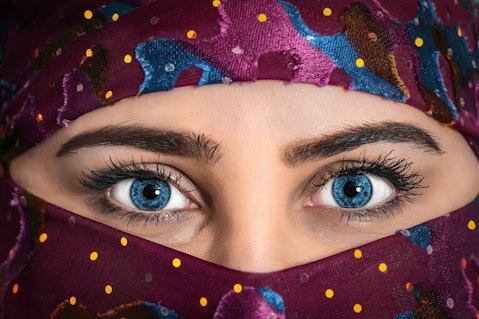Talking about the least sexually active countries in the world might seem intriguing, but it’s far from an easy task. It involves considering numerous details and consulting various research and surveys, many of which rely on questionable data. Honestly, nobody wants to ask or answer questions about their sexual activity, even when asked by urologists or condom manufacturers.
Discussing sexual activity remains taboo in most countries, leading to people not always being forthcoming about it. The concept of “average” sexual activity becomes a complex question, especially in sexually repressed countries. While surveys provide data on the average number of annual sexual encounters, we can’t be certain if respondents were entirely honest. Moreover, we must consider the influence of factors such as culture and religion on people’s perceptions of sexual behavior. While there are most sexually active countries in Europe according to relevant survey, it is difficult to tell what ethnicity is the most sexually active.

Pixabay/Public domain
Religion plays a significant role in shaping attitudes towards sexual activity, and this connection can be controversial. When discussing sexual freedom in each country, we cannot ignore the impact of religion. While many modern countries have more liberal views on sexuality, traditional and religiously conservative countries often exhibit different attitudes. It is why is list of sexless countries usually includes those where religion has high impact.
Economically developed countries with strong human rights and sexual freedoms are less influenced by religion so they are the most sexually active countries. However, in countries with rigid religious practices, the impact on sexual behavior is more pronounced. Even the younger generation’s attempts to break free from this influence may not entirely escape its effects if they grew up in deeply religious environments. Estimating which is the most sexually open country in the world in the world is a challenging task. While some countries may have a high level of sexual drive and be more liberated in terms of sexual behavior, it’s not necessarily a clear indicator of them being openly free about sex. The real difficulty arises when trying to gauge the level of sexual openness in sexually repressed countries. It’s hard to determine how much they engage in sexual activities and freely discuss it within the confines of their private spaces.
Creating a list of sexless countries is difficult job, so in our research, we considered data that we deemed accurate and relevant to this topic. We compared the list of the most promiscuous countries with the most religious countries and the average number of sexual partners per country. By combining their rankings, we arrived at an average position, which allowed us to rank the least sexually active countries in the world. It would be great if we are able to tell which is the most sexually active city in the world, so you can go to visit it now. Therefore, even the most sexually immoral country in the world would not openly advertise themselves as such. Instead, we have to depend on information provided by tourists, visitors, and official surveys to gain insights into the level of sexual behavior and attitudes within a country.
Now, you can see the list of these countries based on available surveys. However, due to cultural sensitivities and privacy concerns, gathering entirely precise data in this area can be challenging. Still, we did our best to provide an informative and insightful analysis.

Pixabay/Public domain
20. China
People in China reported average 96 intercourses per year so it deserves to be on the least sexually active countries in the world. It is noticed that in China the link between better health and sexual satisfaction becomes evident among older adults. Those with better overall health and who can openly discuss their sex life with their partners are more likely to report higher levels of sexual satisfaction. Women showed a positive association between sexual activity and better self-reported general health and lower levels of disability. These findings suggest that promoting better health and communication about sex can enhance sexual satisfaction, especially among sexually active older adults.
19. Taiwan
The survey results showed that 2.8% of the women were sexually inactive in the previous month, while 83.67% had intercourse between one to nine times, and 13.56% had intercourse ten times or more during the same period. On average, the frequency of sexual activity among the participants was 6.8 times a month. Interestingly, sexual activity in the last month showed a significant decrease with age. For women aged 25 years, 99.65% reported having had sexual intercourse, while the percentage decreased to 98.94% for those aged 35-39, 94.75% for those aged 45-49, 68.15% for those aged 55-59, 58.6% for those aged 60-64, and 40% for women aged 65 or older (p < 0.0001). These findings suggest that sexual activity tends to decline with age among the surveyed women.
18. Vietnam
The cultural emphasis on virginity and the expectations surrounding sexual behavior may indeed contribute to the average number of sexual partners in Vietnam being relatively low at 3.20. The societal norms and values play a significant role in shaping people’s attitudes towards sex and relationships. With a strong emphasis on preserving virginity and traditional family values, individuals in Vietnam may be less likely to engage in casual or multiple sexual relationships compared to societies with more liberal views on sexuality. It’s essential to consider the cultural context and social factors when understanding the patterns of sexual behavior in different countries.
17. Malaysia
The study conducted in Kuala Lumpur in 1986 surveyed 1,200 Malaysian adolescents aged 15-21 years. The research aimed to understand various sexual behaviors, including premarital sexual intercourse, contraceptive usage, and masturbation. Among the 1,181 unmarried respondents, 9% (105 individuals) reported having engaged in sexual intercourse, with males being significantly more experienced than females. The study also found that older age groups were more sexually active than the younger ones. These findings provide valuable insights into the sexual behaviors of Malaysian adolescents during that period. However, the number of sexual intercourses per year is only 86.
16. India
India is a diverse country with significant social, cultural, and sexual differences. The concept of sexuality in India has evolved over time and has been shaped by various rulers and religions. The sexuality is reflected in how they dress, behave, engage in recreation, express themselves through literature, sculptures, scriptures, religion, and sports. It also influences their views on health, disease, and remedies. In the modern era, with globalization, Indian sexuality is experiencing change. According to study, they had only 75 intercourses annually.
15. Singapore
Singapore should be included in our list of the least sexually active countries in the world, even though comprehensive research on sexual activity in this country might not be readily available. To plan education programs against sexually transmitted diseases (STDs) and HIV infection, a survey on partner relations was conducted among 2,115 Singaporean men and women aged 15 to 49 years. Among the married individuals, 76.9% of men and 98.6% of women had their first sexual encounter with their current or future spouse. Regarding casual sex, 16% of sexually experienced men engaged in it in the previous year. Out of these encounters, 78.4% were with commercial sex workers. Average, people in Singapore had 73 intercourses last year.
14. Morocco
Sexuality remains one of the tabooest subjects in this country, especially among the female population. This highlights the importance of implementing sex education that starts with self-awareness, understanding various practices, and providing psychological support to all women from a young age to foster a healthy and fulfilling sex life. In Morocco, the influence of religion is significant, and approximately 30% of the population is considered promiscuous. Maybe Morocco should not be on the first place on the list of the least sexually active countries in the world, but it surely deserves to be on the list.

Pixabay/Public domain
13. Philippines
Despite the influence of Westernization and globalization on Filipinos living in metropolitan areas, the overall culture remains conservative in its sexual values. Filipino sexuality is shaped by factors such as education, media, internet access, religious teachings, legal policies, and urbanization. The statistics show the evolving trends in Filipino youth’s sexual behaviors over the years.
12. Thailand
Despite the perception of Thailand’s open attitude towards the sex industry, the reality is that many Thais are quite shy and conservative when it comes to discussing sex. In Thai culture, talking about sex is considered taboo, and this is reflected in the media and entertainment industry. In certain settings, like universities, there are restrictions on clothing, and miniskirts have been banned to uphold conservative values. Despite the apparent openness in some aspects of Thai culture, the underlying conservative attitudes towards sex are still deeply ingrained.
11. Turkey
In one study, it was observed that the age at which individuals had their first sexual intercourse was mostly within the 18-24 age group, regardless of gender. When it came to the frequency of sexual intercourse, 42% of women reported having it twice a week, while 38% of men reported 3 or 4 times a week. Regarding the initiation of sexual intercourse, 46% of women said that their husbands usually initiated it, whereas 34% of men said that both they and their wives initiated it together. The study also revealed that 32% of both women and men replied that the average duration of foreplay was between 7-10 minutes. Turkey had the highest number of average partners, even 14, though.
10. Israel
A study conducted in Israel surveyed 5198 high school students, representing the entire country’s age group, except for 13% attending religious schools. The findings revealed that approximately one-third of boys aged 14-15 years and almost half of those aged 16-17 years had experienced sexual intercourse. The study also found that boys generally had a higher level of knowledge about sex compared to girls. Students of Oriental origin and those considering themselves religious or traditional tended to be less sexually active, more conservative in their attitudes, and less knowledgeable about sex. Among sexually active girls, over 80% reported having intercourse with just one partner, while only 40% of boys said the same. The reasons cited for first intercourse included love, sexual drive, curiosity, and spontaneous action.
9. Indonesia
In a significant blow to freedoms in Indonesia, the country’s parliament has recently revised the criminal code, criminalizing sex outside of marriage and imposing restrictions on free speech. This move has caused alarm not only among rights activists but also in the thriving tourism sector, which heavily depends on visitors to its beautiful tropical islands. The legislation received support from all political parties, making it a drastic and concerning development for the world’s third-largest democracy.
8. Peru
The ancient Peruvian clay models portrayed women in various sexual scenes, depicting them as both receptive partners and producers of bodily fluids. The artwork also showed women as sexually active individuals, actively participating in the emission of seminal fluid produced by their male partners. Considering this historical openness towards sexuality, today’s perspective in Peru has only slightly evolved. A significant percentage of the population, about 84%, identifies as religious, while only around 30% consider themselves to be promiscuous individuals. This shift reflects the changing cultural norms and attitudes towards sexuality in modern Peru.
7. Serbia
In Serbia, women often report having many friends (44%) and being financially dependent on their parents (67%) while studying. Their first sexual experience usually occurs at the age of 17 (20%), and almost half of them have sexual experience with only one partner (46%). The main motive for sexual activity is being in love (64%), and overall, they express satisfaction with their sexual life (64%). Despite 69 percent of Serbs considering sex important in their lives, a significant portion, 54 percent, still views sex as a taboo. Additionally, 72 percent believe that people should pay more attention to the issue. Compared to other countries in this survey, Serbs reported the lowest level of sexual activity, with only 34 percent of men and 31 percent of women having sex more than twice a week.

Pixabay/Public domain
6. Malta
According to the first study of its kind in Malta, people living in the northern part of the country watch pornography the most, while those in the southern harbor area have sexual intercourse most frequently. The study aimed to shed light on people’s sexual behaviors and reduce stigma surrounding sexuality. Being declared as a highly religious country, with more than 86% of its population identifying as religious, Malta is a place where sexual activity remains a taboo subject. The cultural and religious influences have created an environment where discussions about sex are often avoided or considered sensitive. As a result, topics related to sexuality are not openly discussed, and there may be a sense of discomfort or hesitancy in addressing such matters.
5. Romania
Romania, as a highly religious country, maintains conservative attitudes towards sexual behavior. These cultural and religious influences contribute to a societal environment where discussions about sex are often considered sensitive and may be avoided. As a result, topics related to sexuality are not openly discussed, and there might be a sense of hesitancy in addressing such matters. In Romania, the sexual experiences of Roma women typically begin during adolescence, with a significant portion (63.9%) having their first sexual intercourse between the ages of 15 and 19. Additionally, 26.7% of Roma women experience their first sexual encounter at age 15, and 9.4% between ages 20 and 24. It was observed that Roma women with lower levels of education tend to initiate their sexual lives earlier. For instance, 28.8% of Roma women with no education had their first sexual intercourse before the age of 15, and 64.8% between the ages of 15 and 19.
4. Slovakia
Sexologists in Slovakia express some dissatisfaction with the current state of sex education in the country. While the state does support certain sexual education programs, there are concerns about the comprehensiveness and consistency of the information provided. In the basic school curriculum, students receive some basic knowledge about sexual anatomy and physiology. However, topics such as contraception, sexual hygiene, and safer sex practices are not consistently covered, or may even be omitted altogether. According to a survey, Slovakian individuals reported an average number of sexual partners during their lifetime to be around 5.
3. Japan
Among the respondents, 13.0% of women and 13.2% of men reported engaging in sexual activity, including with commercial sex workers, at least once per week in the past year. The frequency of sexual activity was highest among women aged 20-29 years and decreased steadily with age. For men, the proportion reporting weekly or more frequent sexual activity was highest among those aged 30-39 years. On the other hand, 45.3% of women and 44.5% of men reported not having had any sexual partners, including commercial sex workers, in the past year. The highest proportion of individuals with no sexual partners in the last year was among women aged 40-49 years (51.7%) and men aged 20-29 years (55.1%).